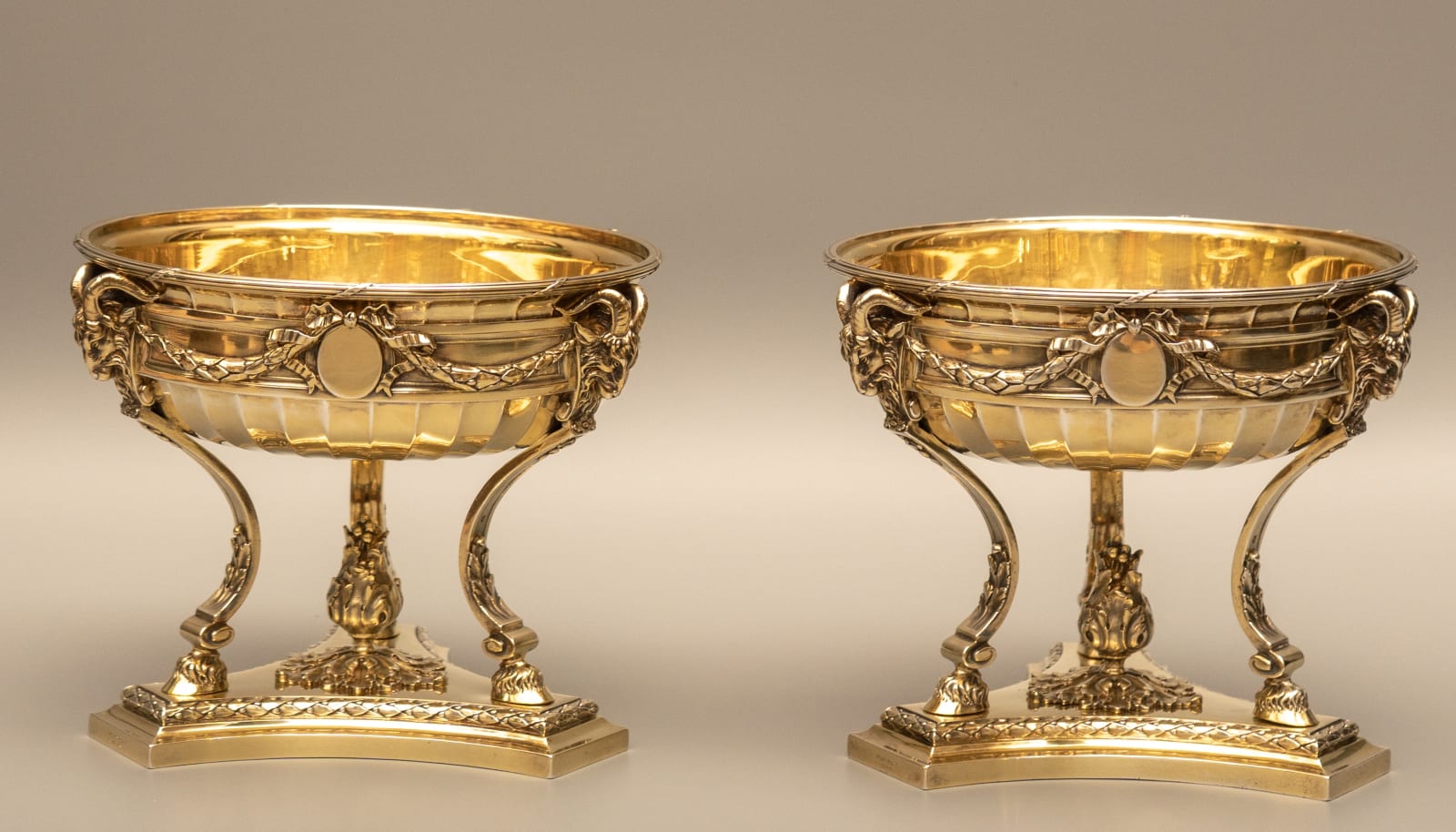Puiforcat
A superb pair of French late nineteenth century Louis XVI-Empire style silver-gilt dishes by Puiforcat à Paris, each with a removable solid silver liner, with a frieze mounted by three long horned rams head masks, which are centred by a ribbon-tied oval medallion and joined by laurel leaf swags above a fluted body, with each of the rams head masks heading a curved concave shaped tripod support terminated by a hoofed foot, resting on a concave-sided tripartite plinth with laurel leaf banding centred by a berried foliate finial on a stepped tripartite base, each silver-gilt dish and each of their silver liners fully hallmarked
Paris, date circa 1890
Height 18 cm, width 21cm. each.
Weight with silver liner 2150 gms, weight without the liner: 1170 gms. each.
Of exceptional quality, this highly elegant pair of dishes was made by the eminent Parisian silver manufacturing firm of Puiforcat. They epitomise the interest in past historical styles that prevailed in Europe during the latter part of the nineteenth century. As one art critic noted, when describing the jewellery and silver table ornaments shown at the Paris Exposition Universelle in 1881: “Louis Quatorze, Louis Quinze and Louis Seize – these motifs are all the rage,” (“The Jewellery & Metalworker”, 1st March 1890, p. 78). Puiforcat, along with other leading Parisian silversmiths such as Boin-Taburet, Odiot, Falize and Boucheron was one of many to exhibit a highly eclectic range of styles at this period, in which they borrowed and adapted designs from previous generations to create entirely new pieces for the luxury market.
The design for the present dishes is a synthesis between the late eighteenth century Louis XVI style and that of the early nineteenth century Empire, in which classical design and decorations, such as the rams heads, ribbon-tied medallions, laurel leaf swags, as well as symmetrical forms, predominate. More particularly the foliate finials look back to the Louis XVI style while the fluted bodies and overall crisp, clean-cut lines are more akin to the work of the Empire silversmiths such as Martin-Guillaume Biennais (1764-1843) or Jean-Baptiste Claude Odiot (1763-1850). The result is a happy marriage between the two classical styles that also combine aesthetics with practicality.
By the time that these dishes were created, Puiforcat had moved into the high end of the silversmithing trade, gaining particular renown for creating pieces inspired by past historical masterpieces, often based upon objects from within the company’s own collection. For instance, among similar items, one can cite a pair of Louis XVI circular silver salières with blue glass liners, made circa 1778/79 by the royal goldsmith Marc-Etienne Janety (1739-1820), which were one of many silver objects from the Puiforcat collection that were eventually acquired by the Musée du Louvre, Paris (OA 9874 1). As here, the salières feature ribbon-tied medallions between laurel leaf swags, and instead of rams heads, are mounted by lions heads and are raised on four, rather than three supports.
The history of this renowned firm began in 1820, when Joseph-Baptiste Fuchs (1795-1870) established a cutlery shop in the Marais district of Paris. Fuchs was then joined by his maternal nephew Émile-Louis, better known as Émile Puiforcat (1820-83), who in 1857, together with Fuchs, registered the Puiforcat hallmark. In addition to Émile Puiforcat, Fuchs was also assisted by Émile’s brother, Joseph-Marie-Pierre Puiforcat (b. 1814) at rue Chapon, Paris. The latter and Émile were the sons of Félix-Amand Puiforcat and his wife, Jeanne (née Fuchs), but it was Émile, who was the original driving force behind his firm’s development. Initially they worked as cutlers but in due course the business expanded into the luxury silver market.
Émile married Joséphine Françoise Stern in 1845 and in due course, their son Baptiste-Joseph-Joseph Puiforcat (1846-90) joined the business. The latter and his wife Joséphine Amandine had at least three daughters of which their eldest, Laure Emilie Puiforcat (1873-1960), united the family concern with another leading firm of orfèvriers when in 1892, she married the silversmith Louis-Victor Tabouret (1867-1955). In 1902, a decade after his marriage, Louis-Victor Tabouret assumed management of the firm of Puiforcat and then in 1915 he changed his surname by decree to Puiforcat-Tabouret. Under Louis-Victor’s guidance, the firm continued to be recognised for its high-quality work, he was also the author of “L’orfevrerie Francaise et Etrangere” and among his many accolades was nominated a Chevalier in 1926 and then an Officier de l’Ordre de la Légion d’Honneur in 1938 for his contribution to silversmithing. Louis-Victor Tabouret was also a passionate collector, who sought out the finest masterpieces by royal silversmiths of the sixteenth and seventeenth centuries, drawing inspiration from these treasures to enhance the catalogue of the silver holloware brand including a repertoire of tea services, soup tureens, elegant toiletries, etc.
It was, however, Louis-Victor and Laure Puiforcat’s son Jean Elisée Puiforcat (1897-1945) who was to establish the company within the realms of avant-garde modern silverwork during the first part of the twentieth century. Having trained in London at the Central School of Art, Jean Elisée Puiforcat then studied under the sculptor Louis Lejeune and joined his family’s firm after the First World War. Named as a master silversmith in 1920 and an undisputed leader of the Art Deco style he became a founding member of the Union des Artistes Modernes in 1929. With his passion for sculpture and design, he introduced a revolutionary formal language that advocated adapting form to suit function - which was also an aspect achieved by his predecessors. His clear-cut style, characterised by pure, architectural lines, notable simplicity and the marriage of solid silver with other precious materials such as exotic woods, semi-precious stones and shagreen, inspired by Art Deco, was to prove the founding stone for contemporary high-end silverwork.
